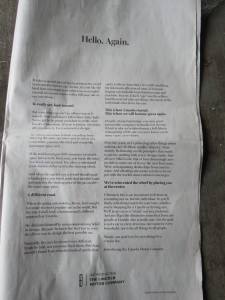
As a technologically savvy consumer who’s not excited by the current crop of luxury cars, I should be the perfect target for the reimaged Lincoln. Yet the full page ad in Saturday’s Wall Street Journal had me scratching my head. (I haven’t been able to find the full text anywhere online so I’ll shoot it at hopefully high enough resolution that you can read it for yourself.)
As a copywriter, I love long copy ads that succeed and hate long copy ads that make skeptics say “long copy doesn’t work”. This ad, unfortunately, is in the latter camp. Let’s examine why:
1. Lincoln assumes a coziness which is not likely to exist between ad and reader. Sadly, today’s consumer is not enamored with our silken prose and is more likely to turn the page than to read the copy. Witness the headline which, out of all the infinite possibilities, says “Hello. Again.” And a first paragraph that says, “It takes a special type of ego to presume the world needs another luxury car. (In fact, it’s a bit like the kind that interrupts your otherwise meaningful pursuit of current events with a full-page ode to our intentions.)” Lincoln, we could care less about your ego.
2. The ad has a tin ear. Here’s an aspirational statement in the second paragraph: “True trailblazers follow their inner light. You’ve got to be pretty confident to create what has never been done before. It’s true in history, invention, art, you name it. Even automotive design.” Pretty high-minded and soul-stirring.
But here’s their proof point in the very next paragraph: “If the traditional gearshift consumes too much space between the front seats, you break the rules. You break new ground. You place a redesigned push-button shifter next to the steering wheel.” Not only is that a terrible letdown from the aspirational high, it’s not even new. I had such a shifter in my 1963 Rambler.
3. Lincoln steps on his own coat tails in attempting to be all things to all consumers. The brand wants to be “what has never been done” as noted above. But they also want to build on their heritage, as the ad progresses. Past Lincolns are presented as “different… truth be told, not everyone liked them” and the “selfless” (sic) ego of Edsel Ford is brought forward as the kind of pure design fire that burned brightly. (When people think “Edsel” they think of the car, of course, with all its quirks, not the man.)
If you are brand new, then you’ve broken away from any history you have. Instead they’ve chosen to bring up the history, then belittle it or suggest that Lincoln has been misunderstood. I don’t think you can have it both ways. And there is also the television advertising to deal with, presenting the Lincoln as the “car of presidents” (as in presidential limo) which makes it seem like a mainstream choice and not an eccentric outlier. More discontinuity.
Finally, at the end of the ad, we’re told what lies in store for us: “elevating our owner service to be on par with the world’s most exclusive concierges… we’ll treat you as a ‘client,’ not as a customer… simply, our goal is to be everything for a certain few.” Here I know what is happening because I did some work for Lexus in the early 90s, when they were eating Infiniti’s lunch. The two new luxury brands were launched at the same time. Infiniti then, like Lincoln today, came forth with dreamy high-minded metaphors and poetic-sounding prose. Lexus simply said, we’re going to pamper you like you’ve never been pampered before.
So Lincoln is going to be both Infiniti and Lexus in the same body. We’re dreamers and unabashed egoists, but when push comes to serve we’ll open the door for you and give you a free carwash with your oil change. Actually, according to Yahoo! News, the promotional plans include a “date night” in which consumers get a free dinner for two when they take a test drive. Now that might get my attention. As long is it’s not Olive Garden or TGIF Friday.